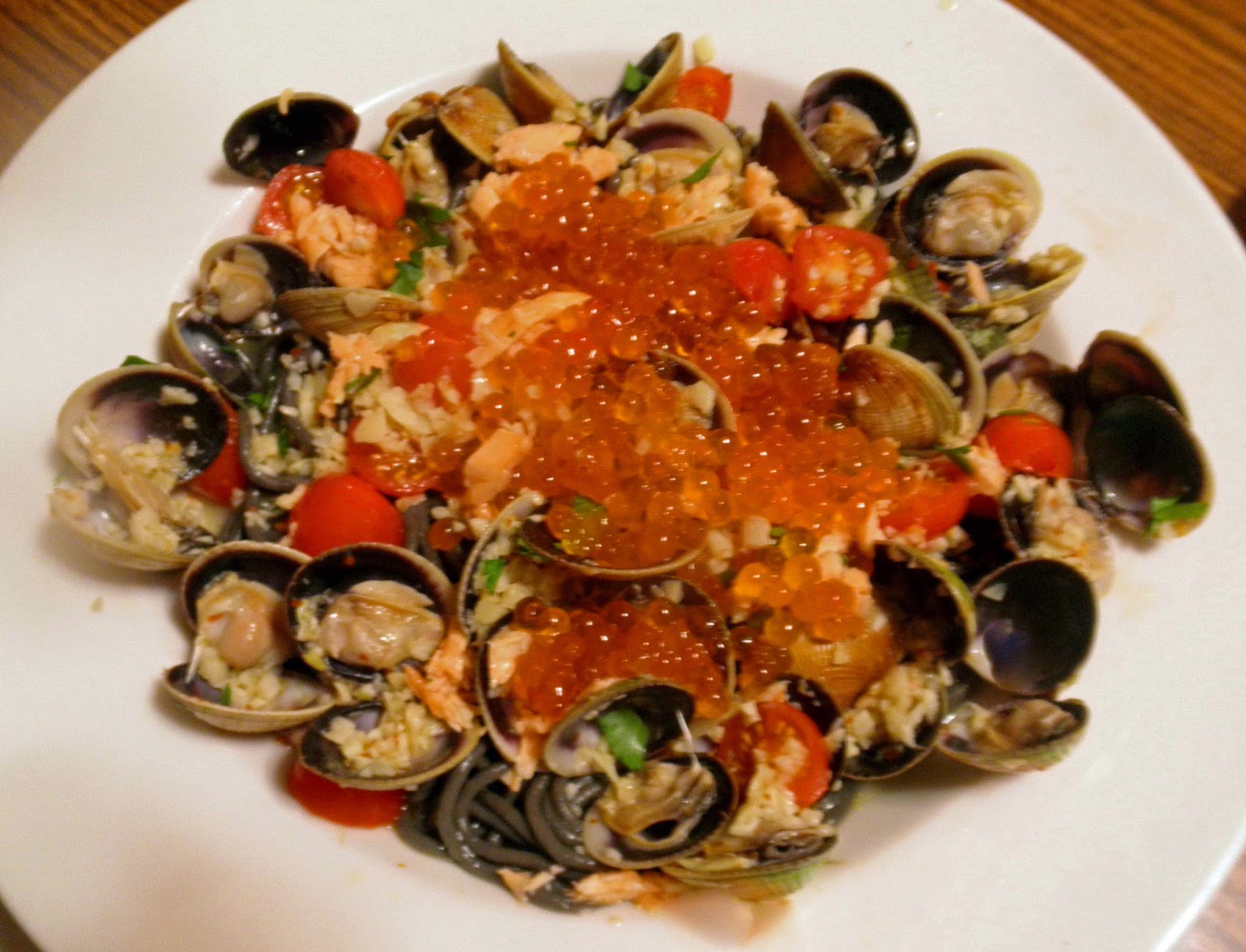 |
| Baked Herbed Salmon with Lentils |
The
first time I made Herbed Salmon with Lentils and Red Wine Sauce was in
1996. It was from a recipe that appeared
in the February issue of FOOD & WINE Magazine and has become another one of
my favorite go-to dishes since then.
There
are hundreds of recipes available for the classic salmon and lentils
combination, but since both the salmon and lentils are prepared separately,
there is a lot of flexibility and creativity for making each part.
The
herbed salmon could be seared in a skillet on the stovetop, grilled on the
grill, or baked in the oven. The seared or grilled versions result in a salmon
with a crust, while the baked kind creates a moist herbed topping sans crust. For this recipe, I baked the salmon, and as
can be seen in the photo, there are plenty of herbs without a crust.
Any
method works well and the end result is a moist pink, flaky fish inside. Of
course, if someone wants the salmon to be well
done, then the cooking time could be adjusted accordingly.
And
for the lentils, I tried making them several ways by first adding them to the
pan covered with water and then adding the vegetables. Alternatively, I tried sautéing the vegetables
first, and then added the lentils and water or a flavored broth. Either way, I found that they almost always
never cooked as the suggested time listed in the recipes. Typically, they would require an additional 20-30
minutes.
Finally,
the Red Wine Sauce adds a slight tartness to the dish. It does not overpower the fresh herbs or
sweetness of the salmon or the tenderness of the lentils which absorb all the
flavors.
For the Salmon:
Yield: 2 Servings
2 fresh tarragon sprigs,
leaves finely chopped, stems reserved
2 fresh flat-leaf parsley
sprigs, leaves finely chopped, stems reserved
2 fresh chives, finely
chopped
1/4 teaspoon kosher salt
Finely grated zest of 1
orange, about 1 Tablespoon
1/4 teaspoon freshly
ground pepper
2 6-ounce skinless salmon
fillets, about one-inch thick
Extra oil virgin olive oil
(for drizzling or sautéing salmon prior to cooking)
In a small bowl, mix
together the chopped tarragon, parsley, chives, kosher salt, orange zest and pepper. Spread the herb mixture evenly on both sides
of the salmon and arrange the fillets in a large baking dish. Marinate in the refrigerator for about 3-4
hours.
 |
| Salmon with Herbs |
For the Lentils:
Yield: 3-4 cups cooked lentils
1
1/2 cup French green lentils, rinsed and picked over
1
Tablespoon extra virgin olive oil
1
onion, peeled and chopped into 1/2 inch dice
1
carrot, peeled and chopped in 1/2 inch dice
1
celery stalk, chopped into 1/2 inch dice
4
large garlic cloves, minced
4
fresh thyme sprigs
Kosher
salt, to taste (about 1/2 teaspoon)
Water,
about 2-2 1/2 cups
 In
a medium saucepan over medium heat, heat the olive oil until it slides across
the pan. Add the chopped onions, carrots,
celery, garlic, thyme sprigs and salt, and cook stirring occasionally, until
the vegetables soften, about 15 minutes.
In
a medium saucepan over medium heat, heat the olive oil until it slides across
the pan. Add the chopped onions, carrots,
celery, garlic, thyme sprigs and salt, and cook stirring occasionally, until
the vegetables soften, about 15 minutes.
Add the lentils and enough water to cover lentils (about 1-1 1/2 cups)
and bring to a simmer. Simmer until the
water no longer covers the lentils, about 30 minutes. Add salt and more water (about 1/2 cup) so
the lentils are once again covered.
Continue cooking, adding more water, until the lentils are tender, about
30 minutes more. Discard thyme sprigs
prior to serving. The lentils can be
stored in the refrigerator for up to one day.
Reheat before serving.
 |
| Cooked Lentils |
For the Red Wine Sauce:
Yield: 3/4 cup sauce
 |
| Red Wine Sauce Prep |
1
cup dry red wine, such as Cabernet Sauvignon
1/2
cup port
1/4
cup red wine vinegar
1
small shallot, minced
Reserved
tarragon and parsley stems
1/2 stick (2 ounces) cold
unsalted butter, cut into ½-inch dice
In
a non-reactive medium saucepan, combine the red wine, port, red wine vinegar,
shallots and tarragon and parsley stems.
Boil over high heat until reduced to 1/2 cup, about 15 minutes. Strain the mixture into a small non-reactive
saucepan and bring back to a boil over moderate heat. Lower the heat and gradually whisk in the
butter until the sauce is slightly thickened; do not let the sauce boil. Season with salt and pepper and keep warm.
To Finish Salmon:
Preheat oven to 450
degrees.
Remove salmon from
refrigerator at let it sit at room temperature for about 20 minutes.*
Drizzle salmon with extra
virgin olive oil and place in the oven for about 7-8 minutes, or until desired
doneness. Remove from oven and let
salmon rest for about 5 minutes.
*Alternatively, after
reaching room temperature, the salmon could be sautéed instead of cooked in the
oven. Heat a large, heavy cast-iron
skillet. Brush the herbs from the salmon. Drizzle bottom of skillet with olive
oil. Cook the salmon fillets over
moderate heat, turning once until nicely browned and just opaque throughout,
about 4 minutes per side.
To Plate:
Make
a bed of the lentils on each plate. Set the salmon fillets on top, spoon the
red wine sauce over the fish and lentils and serve.
 |
Herbed Baked Salmon with Lentils (Side View)
|

 Bourbon
smoked pepper
Bourbon
smoked pepper




































